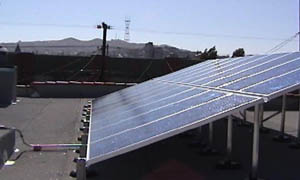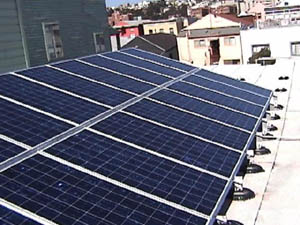Thursday, April 12, 2007
How jumpSLIDE is Greening the Grid

There has been a lot of talk in the IT world recently about "greening the grid," and exciting new
collaborative efforts to look at reducing power consumption from the desktop to the data center.
We're doing our part at jumpSLIDE networks where we think that SMB technology consultants can play a major role in reducing energy consumption. About 3 years ago, we added a 2.5kw solar array to our home/office in the sunny San Francisco Mission district. At the time, we were putting a new roof on our house when we chose to not only go solar but also reinforce and insulate our roof for better energy efficiency. The solar system, which uses cogeneration and time of use metering to sell power back to PG&E brought our then $120/mo electric bill down to $0.
After the first year, we learned that if you produce more energy than you consume, PG&E takes the difference, rather than giving you a credit you can use on your natural gas, or giving transferrable credits you can donate to a non-profit or use at another business location. To me, that's criminal. So instead of giving away our power to PG&E, I have brought a lot of our development machines inhouse.
While we continue to maintain servers at a colocation facility with failover power, etc. and do our hosting externally through
Bluehost, we run about 4 development servers on a rack here, where we can utilize our surplus solar power.
It's our hope that soon battery optimization of hybrid vehicles will become more affordable and accessible so that our Toyota Highlander Hybrid (seen in
Geek My Ride) can plug in at night to use some of that power as well.
Until then, we're enjoying life in the sun. And on the test bench for later in 2007 is a quiet and energy-efficient desktop system that's Vista-ready.

Project: Go Solar
How we did it: 1. Get inspired. Check out Dwell Magazine and see some of the cool applications of energy efficient appliances in your home/office.
2. Do your research on what kind of state/federal/local incentives are out there to make your project more affordable. Usually your prospective vendors will help you here.
3. Talk to multiple vendors and negotiate. We're lucky to be in the Bay Area, where it was easy for me to get quotes on our project from 3 different vendors, which allowed me to get the best price from the vendor I liked the most. The bidding process is also your best chance to get lots of information for free. Potential vendors will help you size your array and find the best location (you've got to have southern exposure!). We used:
Occidental Power and were really happy with their work.
4. Include solar or other energy efficient measures in other improvement jobs to save costs. We put in solar and insulated our roof when we needed to replace the roof. Doing so probably saved us thousands of dollars.
How To: Go Solar (From
Wired Magazine January 2007)

You may not be the first on your block to install photovoltaics, but you can be extra-smart about your D.I.Y. project.
* Evaluate your access to the sun. If a few of the cells on a panel end up in the shade, power generation can drop by 85 to 90 percent.
* Choose the right system. Want a house that produces all of its own electricity? Opt for monocrystalline or polycrystalline panels. They're the most efficient – and the most expensive. Amorphous photovoltaics are roughly half the price but only about half as efficient. If you can't bear the appearance of those big black roof slabs, go with building-integrated photovoltaics (BIPV). Your normal-looking roof and windows become solar catchers.
* Optimize your positioning. One rule of thumb: Subtract 20 degrees from your latitude to find the best angle for mounting. In Seattle, latitude 47 degrees north, you'd want to install your panels at a 27-degree angle facing due south.
* Pump it up a notch and install a solar collector, a kind of water heater that sits on your roof. An antifreeze-like liquid runs through the collector and then through pipes down to your storage tank, translating warmth from the sun into steam in the shower.
Tuesday, April 10, 2007
ctrl+alt+del on Parallels
another Parallels tip:
Use Ctrl-Alt-Fn-Backspace.
Note, that it's necessary to press keys exactly in that sequence. E.g. Fn-Ctrl-Alt-Backspace won't work.
Right click on Parallels
Something I kept meaning to look up and finally did, how to right click when using Windows on a Mac via Parallels (as of at least build 3188): shift+ctrl and click.





